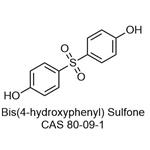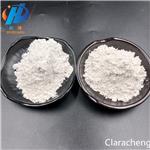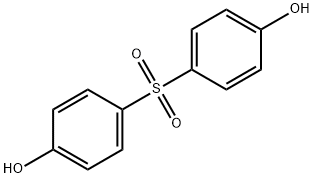Exploring the Properties, Applications, and Safety of Bis(4-hydroxyphenyl) Sulfone
Jan 4,2024
General Description
Bis(4-hydroxyphenyl) sulfone is a sulfone compound with white needle-like crystals. It is soluble in aliphatic hydrocarbons, alcohols, and ethers, but insoluble in water. The compound has two hydroxyl groups and a sulfone group, making it more acidic than other phenols. It is used as an intermediate in the production of fine chemicals, electroplating solvent, washfastening agent, and a component in phenolic resins. However, Bis(4-hydroxyphenyl) sulfone is classified as a hazardous chemical with reproductive toxicity and can cause eye irritation. Proper handling and disposal methods are required. Manufacturers must comply with environmental and public health regulations.

Figure 1. Bis(4-hydroxyphenyl) Sulfone,
Properties
Bis(4-hydroxyphenyl) Sulfone, also known as 4,4'-Sulfonyldiphenol, is a sulfone compound that is structurally similar to bisphenol A (BPA). It exists as white needle-like crystals and is freely soluble in aliphatic hydrocarbons, soluble in alcohols and ethers, slightly soluble in aromatics, but insoluble in water. The molecule of Bis(4-hydroxyphenyl) Sulfone contains two hydroxyl groups and a strong electron-absorbing sulfone group, making it more acidic than other phenols. Computed properties of Bis(4-hydroxyphenyl) Sulfone include a molecular weight of 250.27 g/mol, XLogP3 value of 1.9, two hydrogen bond donor counts, four hydrogen bond acceptor counts, and two rotatable bond counts. Its exact mass and monoisotopic mass are both 250.02997997 g/mol. The compound has a topological polar surface area of 83Ų and a heavy atom count of 17. Experimentally, Bis(4-hydroxyphenyl) Sulfone is described as a white, crystalline powder with a melting point of 240.5°C. It is insoluble in water but soluble in ethanol, ether, and slightly soluble in benzene and DMSO. The density of the compound is 1.3663 g/cu cm at 15°C. When heated to decomposition, Bis(4-hydroxyphenyl) Sulfone emits toxic fumes of sulfur oxides. 1
Applications
Bis(4-hydroxyphenyl) sulfone has various applications in different industries. It is used as an intermediate in the production of fine chemicals, such as polymers and paper. It is also used as an electroplating solvent, a washfastening agent, and a component in phenolic resins. The chemical is patented for several applications, including as a developer in thermal paper and as a processing aid. In the manufacturing industry, Bis(4-hydroxyphenyl) sulfone is used as a dye, etching agent, fixing agent, monomer, polymerization promoter, surfactant, and processing aid. In the consumer sector, it is used as an etching agent, fixing agent, intermediates, polymerization promoter, and processing aid. The chemical has been listed as a High Production Volume (HPV) chemical, produced in or imported into the US in >1 million pounds in 1990 and/or 1994. The production volume for non-confidential chemicals reported under the Inventory Update Rule ranges from >1 million to <10 million pounds from 1986 to 2006. Industries that use Bis(4-hydroxyphenyl) sulfone include adhesive manufacturing, paper manufacturing, plastics material and resin manufacturing, printing and related support activities, and textiles, apparel, and leather manufacturing. 2
Safety
Bis(4-hydroxyphenyl) Sulfone is classified as a hazardous chemical with reproductive toxicity. It can cause damage to fertility and the unborn child, according to GHS classification. The material also causes mild eye irritation and no skin irritation in rabbits. In oral studies of rats, it has been observed to cause prolonged estrous cycles, decreased fertility index, and decreased numbers of live offspring at 300 mg/kg/day. The chemical may also cause acute renal tubular changes and weight loss in rats. Hence, Bis(4-hydroxyphenyl) Sulfone requires proper handling and disposal methods. In case of accidental release, the most favorable course of action is to use an alternative chemical product with less inherent propensity for occupational harm/injury/toxicity or environmental contamination. The ultimate disposal of the chemical must consider its impact on air quality, potential migration in soil or water, effects on animal and plant life, and conformance with environmental and public health regulations. Manufacturers of Bis(4-hydroxyphenyl) Sulfone must report preliminary assessment information concerned with production, exposure, and use to EPA under Section 8(a) of TSCA, and submit copies and lists of unpublished health and safety studies under section 8(d) of TSCA. 3
Reference
1. 4,4'-Sulfonyldiphenol. National Center for Biotechnology Information, 2023, PubChem Compound Summary for CID 6626.
2. PubChem Annotation Record for Bisphenol S. National Center for Biotechnology Information, 2023, Source: Hazardous Substances Data Bank.
3. 4,4'-Sulfonyldiphenol. Haz-Map, Information on Hazardous Chemicals and Occupational Diseases, 19979.
- Related articles
- Related Qustion
- Bis(4-hydroxyphenyl) Sulfone: unveiling the toxic effects and reproductive disruptions of a common compound Jul 12, 2023
Recent scientific research has shed light on the toxic effects and reproductive disruptions caused by a commonly used compound, bis(4-hydroxyphenyl) sulfone.
- Uses of Bisphenol S Oct 23, 2019
4,4'-dihydroxydiphenyl sulfone is mainly used as a fixing agent. In addition, it can be used as a plating solution additive, a leather tanning agent, a dispersant for high-temperature dyeing, and Phenol formaldehyde hardener.
Cetearyl alcohol is a white granular solid with wax-like odor, used in cosmetics as a thickening agent, stabilizer, and emulsifier. It is non-toxic but can cause mild irritation to the eyes and skin.....
Jan 4,2024APIBenzophenone imine is a clear liquid with unique properties and versatile synthetic applications, requires careful handling due to its potential for causing skin, eye, and respiratory irritation.....
Jan 4,2024APIBis(4-hydroxyphenyl) Sulfone
80-09-1You may like
Bis(4-hydroxyphenyl) Sulfone manufacturers
- Bis(4-hydroxyphenyl) Sulfone
-

- $0.00 / 1kg
- 2024-05-18
- CAS:80-09-1
- Min. Order: 1kg
- Purity: 99%+
- Supply Ability: 10000kgs per Month
- 4,4'-Sulfonyldiphenol
-

- $0.00 / 25Kg/Bag
- 2024-05-17
- CAS:80-09-1
- Min. Order: 1KG
- Purity: 99%
- Supply Ability: 5000mt/year
- Bis(4-hydroxyphenyl) Sulfone BPS
-

- $20.00 / 25kg
- 2024-04-27
- CAS:80-09-1
- Min. Order: 1kg
- Purity: 99.9%
- Supply Ability: 200000kg




